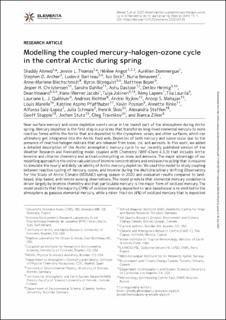| dc.contributor.author | Ahmed, Shaddy | |
| dc.contributor.author | Thomas, Jennie L. | |
| dc.contributor.author | Angot, Hélène | |
| dc.contributor.author | Dommergue, Aurélien | |
| dc.contributor.author | Archer, Stephen D. | |
| dc.contributor.author | Bariteau, Ludovic | |
| dc.contributor.author | Beck, Ivo | |
| dc.contributor.author | Benavent, Nuria | |
| dc.contributor.author | Blechschmidt, Anne-Marlene | |
| dc.contributor.author | Blomquist, Byron | |
| dc.contributor.author | Boyer, Matthew | |
| dc.contributor.author | Christensen, Jesper H. | |
| dc.contributor.author | Dahlke, Sandro | |
| dc.contributor.author | Dastoor, Ashu | |
| dc.contributor.author | Helmig, Detlev | |
| dc.contributor.author | Howard, Dean | |
| dc.contributor.author | Jacobi, Hans-Werner | |
| dc.contributor.author | Jokinen, Tuija | |
| dc.contributor.author | Lapere, Rémy | |
| dc.contributor.author | Laurila, Tiia | |
| dc.contributor.author | Quéléver, Lauriane L.J. | |
| dc.contributor.author | Richter, Andreas | |
| dc.contributor.author | Ryjkov, Andrei | |
| dc.contributor.author | Mahajan, Anoop S. | |
| dc.contributor.author | Marelle, Louis | |
| dc.contributor.author | Pfaffhuber, Katrine Aspmo | |
| dc.contributor.author | Posman, Kevin | |
| dc.contributor.author | Rinke, Annette | |
| dc.contributor.author | Saiz-Lopez, Alfonso | |
| dc.contributor.author | Schmale, Julia | |
| dc.contributor.author | Skov, Henrik | |
| dc.contributor.author | Steffen, Alexandra | |
| dc.contributor.author | Stupple, Geoff | |
| dc.contributor.author | Stutz, Jochen | |
| dc.contributor.author | Travnikov, Oleg | |
| dc.contributor.author | Zilker, Bianca | |
| dc.date.accessioned | 2023-07-10T11:43:24Z | |
| dc.date.available | 2023-07-10T11:43:24Z | |
| dc.date.created | 2023-06-16T14:41:28Z | |
| dc.date.issued | 2023 | |
| dc.identifier.citation | Elementa: Science of the Anthropocene. 2023, 11 (1), 6237-6271. | en_US |
| dc.identifier.issn | 2325-1026 | |
| dc.identifier.uri | https://hdl.handle.net/11250/3077473 | |
| dc.description.abstract | Near-surface mercury and ozone depletion events occur in the lowest part of the atmosphere during Arctic spring. Mercury depletion is the first step in a process that transforms long-lived elemental mercury to more reactive forms within the Arctic that are deposited to the cryosphere, ocean, and other surfaces, which can ultimately get integrated into the Arctic food web. Depletion of both mercury and ozone occur due to the presence of reactive halogen radicals that are released from snow, ice, and aerosols. In this work, we added a detailed description of the Arctic atmospheric mercury cycle to our recently published version of the Weather Research and Forecasting model coupled with Chemistry (WRF-Chem 4.3.3) that includes Arctic bromine and chlorine chemistry and activation/recycling on snow and aerosols. The major advantage of our modelling approach is the online calculation of bromine concentrations and emission/recycling that is required to simulate the hourly and daily variability of Arctic mercury depletion. We used this model to study coupling between reactive cycling of mercury, ozone, and bromine during the Multidisciplinary drifting Observatory for the Study of Arctic Climate (MOSAiC) spring season in 2020 and evaluated results compared to land-based, ship-based, and remote sensing observations. The model predicts that elemental mercury oxidation is driven largely by bromine chemistry and that particulate mercury is the major form of oxidized mercury. The model predicts that the majority (74%) of oxidized mercury deposited to land-based snow is re-emitted to the atmosphere as gaseous elemental mercury, while a minor fraction (4%) of oxidized mercury that is deposited to sea ice is re-emitted during spring. Our work demonstrates that hourly differences in bromine/ozone chemistry in the atmosphere must be considered to capture the springtime Arctic mercury cycle, including its integration into the cryosphere and ocean. | en_US |
| dc.language.iso | eng | en_US |
| dc.rights | Navngivelse 4.0 Internasjonal | * |
| dc.rights.uri | http://creativecommons.org/licenses/by/4.0/deed.no | * |
| dc.title | Modelling the coupled mercury-halogen-ozone cycle in the central Arctic during spring | en_US |
| dc.title.alternative | Modelling the coupled mercury-halogen-ozone cycle in the central Arctic during spring | en_US |
| dc.type | Peer reviewed | en_US |
| dc.type | Journal article | en_US |
| dc.description.version | publishedVersion | en_US |
| dc.rights.holder | © 2023 The Author(s). | en_US |
| dc.source.pagenumber | 6237-6271 | en_US |
| dc.source.volume | 11 | en_US |
| dc.source.journal | Elementa: Science of the Anthropocene | en_US |
| dc.source.issue | 1 | en_US |
| dc.identifier.doi | 10.1525/elementa.2022.00129 | |
| dc.identifier.cristin | 2155325 | |
| cristin.ispublished | true | |
| cristin.fulltext | original | |
| cristin.qualitycode | 1 | |

